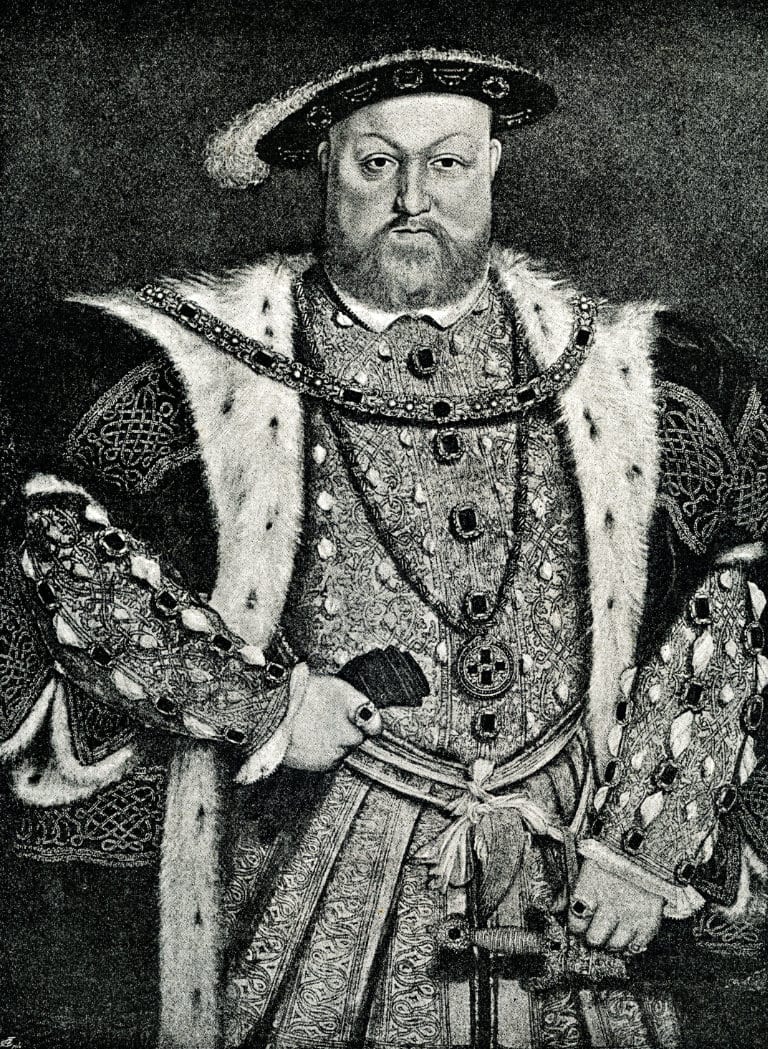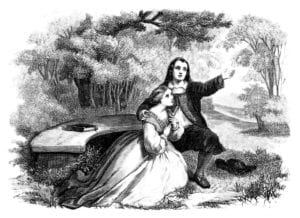Introduction
“Henry VIII” was co-written by Shakespeare and John Fletcher, a younger playwright who succeeded him as resident author for the King’s Men. The play describes the fall of Henry’s first wife Katharine and his chief advisor, Cardinal Wolsey, and goes on to explore the rise of Anne Bullen (or Boleyn) and of Thomas Cromwell and Archbishop Cranmer.
This is the period of the Reformation, when the English church broke with Rome. The play is a History, and aims to present historical events in a reasonably dispassionate way, though it closes with a speech anticipating the glorious achievements of Elizabeth I and James I, rulers of England in Shakespeare’s lifetime.
It might seem that the volley of praise for the Virgin Queen at the end of the play is a touch sycophantic – and in any case, somewhat surplus to requirements: after all, Elizabeth had enjoyed no shortage of positive feedback in her lifetime, and besides, by now she had been dead the best part of a decade.
Sycophantic he may have been from time to time – students of flattery may like to admire Shakespeare’s Dedications to his Patron the Earl of Southampton which open his long poems “Venus and Adonis” and “The Rape of Lucrece”. But he is also an exceptionally brave writer, who in his working life clallenged the boundaries – and there were plenty of them – while keeping his head attached to his shoulders. This was quite a feat: when one John Stubbs wrote a pamphlet in 1579 weighing in against a proposed marriage between the Queen and the brother of the King of France, he had his right hand cut off.
When Shakespeare writes, as he often does, of marriage and divorce, of power and powerlessness, of victory and defeat – and of crime and punishment – among the ruling class, he knows whereof he speaks.
Scene by scene
Prologue
The Chorus warns the play is realistic but sad, unsuitable for people looking for a “bawdy” show.
ACT ONE SCENE ONE
Three English Lords recollect the recent “summit” between the Kings of France and England.
The summit was organised by Cardinal Wolsey, who is criticised here for arrogance and ambition.
Wolsey arrives briefly, and glares at Buckingham with a menacing and threatening expression.
Before Buckingham can speak to the King he is arrested on Wolsey’s authority for high treason.
ACT ONE SCENE TWO
The Queen begs Henry to abandon an unpopular tax recently implemented by Wolsey.
The King agrees and Wolsey arranges to take the credit for withdrawing the tax.
Next a former employee of Buckingham tells the King that Buckingham had designs on the throne.
The Queen questions his motives by revealing that the employee was sacked by Buckingham.
But the King insists on hearing his evidence and ordering that Buckingham be tried for treachery.
ACT ONE SCENE THREE
Two Lords deride and ridicule the latest English fashions, imported from France.
They reveal they are about to go to a banquet being given by Cardinal Wolsey.
ACT ONE SCENE FOUR
Anne Bullen (or Boleyn) is presented as high-spirited and flirtatious at Wolsey’s banquet.
A group including the King, disguised as French shepherds, arrive at the banquet.
The King, recognised by Wolsey, dances with the “dainty” Anne Bullen, and kisses her.
ACT TWO SCENE ONE
Two gentlemen reveal that Buckingham has been sentenced to death for high treason.
They blame the ambitious Wolsey, who jealously destroys anyone the King favours.
Buckingham appears on the way to his execution and forgives his enemies, even Wolsey.
He says that like his father, executed by Richard III, he was a faithful servant to the King.
Two gentlemen gossip about a rumoured separation between the King and Katharine.
ACT TWO SCENE TWO
Some thoroughbred horses have disappeared, apparently sequestered by Wolsey.
The Lords report that Henry is brooding on his marriage, probably provoked by Wolsey.
Suspecting the King is attracted to another, the Lords hope he will one day expose Wolsey.
The cardinal arrives to discuss the royal divorce with the King and the Pope’s ambassador.
Arrangements are left with Wolsey for the announcement to be made of the divorce.
ACT TWO SCENE THREE
Discussing the King’s marriage, Anne exclaims that she would hate to ever be queen.
The Lord Chamberlain arrives to inform Anne that she has been made Marchioness of Pembroke.
ACT TWO SCENE FOUR
Katharine, on trial for her marriage, argues that she has always been loyal and supportive to Henry.
She claims the trial should be delayed so she can receive informed advice but Wolsey refuses.
She accuses Wolsey of “arrogancy, spleen and pride” but he denies that he is behind the divorce.
Katharine storms out of court, leaving Henry to praise her “sweet gentleness” and other qualities.
Wolsey calls upon the King to excuse him from any blame for the breakdown of his marriage.
ACT THREE SCENE ONE
The Cardinals visit Katharine to discuss the King’s matter – she insists the talks are held in public.
Katharine asserts that she has never been less than loving and obedient to the King.
The Cardinals advise her to comply with the decisions the King is taking, so as not to risk his “love”.
She says sarcastically that as a woman she cannot be expected to understand what is at stake.
ACT THREE SCENE TWO
Wolsey has been caught plotting against the King in a series of letters to the Pope.
Meanwhile, the news is announced that the King has already married the “fair lady” Anne Bullen.
Unsuspecting, Wolsey expresses his ambition for the King to marry the French King’s sister.
The King reveals and Wolsey accepts that Henry has seen the papers that will bring Wolsey down.
The nobles give examples of Wolsey’s excessive ambition and greed, and strip him of his wealth.
In the only soliloquy of the play, Wolsey ruefully accepts the narrative of his own rise and fall.
Cromwell informs Wolsey that Sir Thomas More has been appointed Chancellor in his place.
ACT FOUR SCENE ONE
Two gentlemen gossiping before Anne’s coronation reveal that Katharine is now divorced and ill.
Meanwhile, Anne’s appearance is described as beautiful, and her performance pious and dignified.
Cromwell’s promotion as guardian of the crown jewels and member of the Privy Council is revealed.
ACT FOUR SCENE TWO
Griffith recounts to Katharine how Wolsey has recently died a dignified and penitent death.
A vision of six “spirits of peace” in white robes dance over Katharine as she sleeps.
Waking, Katharine sends a message to the King that he may protect their daughter Mary.
She also requests that her serving men and women should be cared for after her death.
ACT FIVE SCENE ONE
Gardiner, once Wolsey’s ally, now aims to undermine the swift ascent of his successor Cromwell.
Meanwhile, Cranmer is informed by Henry that he has enemies who would like to destroy him.
But Henry reassures Cranmer that he supports him, and gives him a ring to reflect this backing.
News arrives that Anne has given birth to a child – “a lovely boy” the midwife tells the King.
ACT FIVE SCENE TWO
Henry sees Cranmer waiting at the Privy Council door and regrets the hostility to him this implies.
ACT FIVE SCENE THREE
At the Privy Council meeting, Cranmer is accused of promoting religious heresies.
Gardiner argues that the Reformation is a “contagious sickness” caught from Germany.
Cranmer replies that he believes in “public peace” and is driven by “love and meekness”.
The Council decides that Cranmer should be imprisoned in the Tower of London.
But Henry’s ring and the personal support of the King preserve Cranmer’s liberty.
He is invited by the King to become a godfather to the infant Princess Elizabeth.
ACT FIVE SCENE FOUR
A crowd of enthusiastic citizens rallies at the gate to celebrate the baptism of the princess.
ACT FIVE SCENE FIVE
At Elizabeth’s baptism, Cranmer predicts that she will be a popular monarch, loved and feared.
He foretells that her successor – James – will inherit her virtues “and make new nations”.
Henry, delighted by these predictions, claims that fathering Elizabeth is his proudest achievement.
He leads the attending Lords to go and pay their respects to the baby’s mother.
The Chorus closes the play by suggesting that at least it has presented “good women”.
Thinking Aloud
From the first scenes it is clear that Cardinal Wolsey is the villain of the piece: he is malicious, dishonest, vain and ambitious. In previous plays Shakespeare has allowed the main villain to address the audience direct through soliloquies: Macbeth for example, and Iago. In this play by contrast, Wolsey is left to operate indifferent to the audience, and there is just a single soliloquy for him, delivered after his downfall.
By the end of Act One, the play has been dominated by Cardinal Wolsey rather than by its eponymous hero. Throughout the play in general, Henry himself is something of a marginal figure.
The first act shows us both Queen Katharine and Anne Bullen. Katharine is modest, serious and high-minded, dutiful in her appearance before Henry in 1.2. By contrast, Anne is presented as spirited and flirtatious in 1.4, a contrast reinforced by the context for these two scenes: Katharine is seen in court by day, Anne at a banquet by night.
The play’s author gives very clear-cut opinions of the characters in the opening scenes of the play: Katharine is insightful and reasonable; Buckingham is loyal but betrayed. Henry is neutral. Wolsey is venal, malicious, dishonest, ambitious. The audience’s sympathies are managed in unambiguous ways.
The analysis being advanced by the play in the opening two acts is that the King was manoeuvred and deceived by Wolsey to divorce Katharine and marry Anne. Given that one of the results of his marriage to Anne was Queen Elizabeth I (who ruled 1558 – 1603), it seems brave of Shakespeare to suggest that her birth was the result of something close to deceit, even treason.
The set-piece trial scene (2.4) is the third trial scene in Shakespeare’s canon, following that of Shylock in “The Merchant of Venice” and of Hermione in “A Winter’s Tale”. Given their self-evident theatricality, it’s perhaps surprising there aren’t more such scenes.
Katharine is repeatedly presented by the playwrights as loving and obedient to the King. In 2.4 and 3.1 in particular (the trial and the Cardinals’ visit), she is allowed to present her own conduct as beyond criticism. Quite a rebuke for Henry for discarding her – except that her replacement with Anne Bullen allows Elizabeth 1 to be born. Nonetheless, the presentation of Katharine is extremely favourable.
Nothing becomes Wolsey’s life so much as his leaving it: in his soliloquy in 3.2 he comes to terms with the fate in store for him, accepting philosophically that his “high-blown pride” is now a thing of the past. Previous Shakespearean villains – Iago, Claudius, Macbeth, Richard III – have been less willing to accept evidence of their own shortcomings, though Albany (in “King Lear”) may be a prototype for the villain who sees the error of his ways.
Until act 4 scene 1, Anne Bullen has been presented as something of an incidental character: flirtatious but less than serious, even somewhat marginal. Nonetheless she is mother of Elizabeth 1, ruler of the country Shakespeare grew up in and predecessor of James, the present king. In their account of her coronation in 4.1, the two gossiping gentlemen restore her dignity and weight to an appropriate pitch.
Archbishop Cranmer’s predictions, delivered in his speech at Elizabeth’s baptism, foretell a momentously happy reign and a successful succession. Both were highly improbable at the time of Elizabeth’s birth, since she was a younger sister (compare with Princess Margaret, younger sister of the present Queen) and because, as a girl, she would be unlikely to inherit the throne even if she were the oldest. The implication of Cranmer’s speech is that the King will not father a son: a prediction which few would have wanted to make at the time.
Characters
Katharine
As she says herself, she has been obedient and loving to the King. But the play also presents her as headstrong and wilful – understandably, in the circumstances. For example in 2.4 she refuses to hear why the King wants a divorce, and in 3.1, confronted with the cardinals, she uses sarcasm to express her anger. Close to death, her thoughts are for others, her daughter and her servants.
Anne Bullen
Initially presented as light-hearted and flirtatious, unfit for the position of Queen and over-promoted, her conduct at her coronation is significantly more dignified and appropriate.
Wolsey
In the first half of the play, Wolsey is presented as the villain of the piece, disliked by everyone except the King. Katharine dislikes him because she believes he is party to the King’s divorce plans; the nobility dislike him because they see him as ambitious and self-interested. However, once his double-dealing has been unmasked, he emerges as reflective and adult, and his obituary, spoken by Griffith in 4.2, describes Wolsey as a character reformed by his setbacks.
Henry VIII
The central character of the play that bears his name, he is nonetheless a somewhat incidental or marginal character, a source of authority but lacking charisma, even personality. Studies in character and motive constitute one of Shakespeare’s great innovations as a playwright – he gives his characters depth and authenticity – but the eponymous hero of this play is somewhat one-dimensional.
Cranmer
Closely supported by Henry and promoted Archbishop of Canterbury, Cranmer fulfils a historical rather than a literary role in the play: that is, he is an essential figure in the story but is not invested by the playwrights with a notable or striking personality. In his evidence to the Privy Council in 5.3 he proclaims himself to be in favour of “public peace” and a meek and humble man.
Quick Quiz
- Who was responsible for the execution of Buckingham’s father?
- What valuable commodity does the letter to the Lord Chamberlain reveal has gone missing?
- What is the title with which Henry honours Anne Bullen in the second act?
- Give the name and title of Queen Katharine’s father.
- Who did Wolsey want the King to marry?
- What does Henry tell Wolsey to do after revealing that he has seen his private papers?
- Identify the two posts to which Cromwell is promoted following Wolsey’s disgrace.
- Where does Wolsey die?
- Which object does the King lend to Cranmer as a symbol of his support?
- Why does the Chorus say it might be difficult to sleep through a performance of this play?
Answers
- Richard iii
- Thoroughbred horses
- Marchioness of Pembroke
- King Ferdinand of Spain
- King of France’s sister
- Have breakfast
- Keeper of the crown jewels and member of the Council
- A monastery in Leicester
- A ring
- Cornets
Last word
“Henry VIII” is not Shakespeare’s most famous play but it provides a footnote to his story. In 1613, soon after the play had been written, a cannon used in the performance fired a cannonball direct into the thatched roof of the wooden theatre, and the result was predictable: the theatre burned to the ground.
As it happens the King’s Men (Shakespeare’s troupe of performers) had recently diversified into an indoor theatre at Blackfriars, and were operating both auditoria simultaneously. The indoor theatre not only provided greater comfort when needed – these were the days when the Thames froze over completely in mid-winter. It also enabled the company to experiment with various theatrical effects that were not realistic at the Globe – like artificial lighting.
The Globe, meanwhile, was rebuilt in a year, and stayed open until those great-grandchildren of the Reformation, the Puritans, closed all London’s theatres a generation after Shakespeare’s death.




